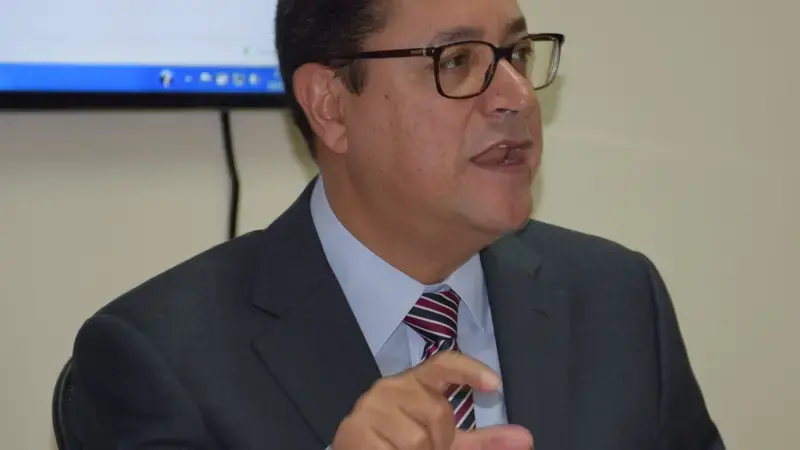Solving tomorrow’s drylands problems today

A conversation with Aly Abousabaa, ICARDA’s new Director General.
A vision of how ICARDA’s science and expertise will help drylands countries improve people’s livelihoods.
Aly Abousabaa took over as ICARDA’s Director General in mid-October. He brings to the center a wealth of experience in research for development, most recently as vice-president of operations in the African Development Bank.
This interview follows Aly’s first dialogue with ICARDA staff, where he set out his vision of ICARDA’s future, the challenges ahead, and the big wins that are expected from its new strategy.
Q: What in your view is special about ICARDA today?
Aly Abousabaa: ICARDA is a deep-rooted organization with 40 years of great scientific achievements in agricultural research in the dry areas. It holds in trust the most precious and largest collection of genetic resources of dryland cereals and legumes, a total of more than 154,000 accessions of wild relatives and landraces of unique source of resistance to major diseases, and tolerance to drought and climate variability.
It is uniquely positioned today to solve the problems of tomorrow with its highly skilled and committed staff, management and Board, building on the institutional resilience demonstrated after departing from headquarters in Syria – and decentralizing to key locations where there is a pressing need for agricultural science and innovation to improve people’s lives. ICARDA’s long experience as the only IARC operating in the non-tropical dry areas makes it a key player in finding solutions to adapt to the climate change. These solutions are key to development efforts for the present and the future and are relevant to both developing and developed countries.
ICARDA also has the confidence and support of the national programs, donors and partners worldwide. Further, ICARDA has a track record of making available validated scientific results and technology packages and services to resource poor farmers which have contributed to improving food and nutrition security at household and national levels, many of which are readily available for scaling up.
Q: What is ICARDA’s new strategy and ‘business model’ all about?
AA: These are still being developed in close consultation with stakeholders but I can tell you that we will be harnessing our collective strengths to build a more effective and efficient organization and demonstrate value for money through results and impacts on the ground that address the challenges facing poor resource farmers not only today but also what we anticipate these challenges to be in the future. ‘Research for development’ is a stated goal of ICARDA and CGIAR, but we need to be more deliberate on how we will make this happen. Our new strategy will make this pathway more explicit and we will focus on priority results and impact in areas such as adapting to climate change; empowering women; improving nutrition; enhancing water and land productivity; crop improvement and raising farmer incomes. Fundamentally, we will be backing the SDGs and the CGIAR goals, as well as the global climate agendas.
Q: As a research organization that produces science, what is ICARDA’s responsibility to directly affect the lives of people? Is this not best done by specialist organizations?
AA: ICARDA’s objective is to change people’s lives. The culture of international research centers, including ICARDA, is to do so through excellence in science for impact. By impact we mean improving the lives of people living in the drylands regions – this is how we will measure our future performance. So our challenge is to link our science to results on the ground. To do this-- building on ICARDA’s success in various subject matters in many countries--we will develop the skills needed and cultivate strong and new partnerships to reach millions of people in communities across the dry areas – so they can benefit from our science and expertise.
Q:To deliver on this approach discussed, you have said that ICARDA needs to transform to keep in step with the changing research for development landscape. Can you elaborate?
AA: Yes. The challenge is to lead a high-performance research center and moving research results to improve the lives of millions. To deliver results, value for money to our stakeholders and impact on the ground, ICARDA needs to be a more responsive and flexible organization. We need to be more innovative, more proactive and extend the use of multidisciplinary and integrated approaches to solve complex problems. We will also have to strengthen a results-oriented culture throughout the organization and strengthen the monitoring and evaluation of our results and impact. My vision to make this happen is:
People: build a culture that will attract and keep the best professionals in drylands research for development. The leadership team will promote and guide culture change.
Information and Communication Technologies – To become a high-performance center with a distributed architecture, we need a world-class ICT infrastructure. Our scientists and management will have a robust information platform where we can collaborate anywhere, anytime.
Partnerships are key. We will partner with our sister CGIAR centers as never before, and open relationships with others who offer expertise along the value chain so that our research can get into use.
Q: Ten years from now, what will success look like?
AA:
- ICARDA is cited and recognized as having contributed to improving the lives of people in the drylands areas;
- ICARDA technologies are contributing measurably to improved food security, job creation and increased income for drylands communities to expand and scale-up our current successes;
- ICARDA is the ‘go-to’ organization for science-informed policy and action;
- ICARDA is widely cited by countries and partners as a vital and trusted partner, whose action and impacts across drylands regions are known worldwide.
